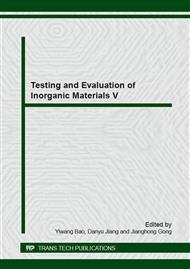[1]
Roussel N, Lemaitre A, Flatt RJ, et al. Steady state flow of cement suspensions: A micromechanical state of the art. Cement and Concrete Research, 2010, 40(1): 77-84.
DOI: 10.1016/j.cemconres.2009.08.026
Google Scholar
[2]
Murata J. Flow and deformation of fresh concrete. Materiaux et Construction, 1984, 17(2): 117-129.
Google Scholar
[3]
Saak A W, Jennings H M, Shah S P. A generalized approach for the determination of yield stress by slump and slump flow. Cem Concr Res, 2004, 34(3): 363-371.
DOI: 10.1016/j.cemconres.2003.08.005
Google Scholar
[4]
Roussel N. The LCPC BOX: a cheap and simple technique for yield stress measurements of SCC. Materials and Structures, 2007, 40(9): 889-896.
DOI: 10.1617/s11527-007-9230-4
Google Scholar
[5]
Hans W R, Wustholz T. About the influence of the content and composition of the aggregates on the rheological behaviour of self-compacting concrete. Materials and Structures, 2006, 39: 683-693.
DOI: 10.1617/s11527-006-9102-3
Google Scholar
[6]
Brouwers H J H, Radix H J. Self-compacting concrete: Theoretical and experimental study. Cement and Concrete Research, 2005, 35: 2116-2136.
DOI: 10.1016/j.cemconres.2005.06.002
Google Scholar
[7]
Bonen D, Shah Surendra P. Fresh and hardened properties of self-compacting concrete. Progress Structure Engineering Material, 2005, 7: 14-26.
Google Scholar
[8]
Yammine J, Chaouche M, Guerinet M, et al. From ordinary rhelogy concrete to self-compacting concrete: A transition between frictional and hydrodynamic interactions. Cement and Concrete Research, 2008, 38: 890-896.
DOI: 10.1016/j.cemconres.2008.03.011
Google Scholar
[9]
Goltermann P, Johansen V, Palbol L. Packing of aggregates: an alternative tool to determine the optimal aggregate mix. ACI Mater J, 1997, 94(5): 435-443.
DOI: 10.14359/328
Google Scholar
[10]
Xu Dinghua, Feng Wenyuan, Practical guidance for concrete material, Beijing: Chinese Building Materials Industry Press, (2005).
Google Scholar
[11]
Funk J E, Dinger D R. Predictive Process Control of Crowded Particulate Suspensions, Applied to Ceramic Manufacturing. Boston: Kluwer Academic Press, (1994).
DOI: 10.1007/978-1-4615-3118-0_46
Google Scholar
[12]
De Larrard F. Concrete mixture proportioning: a scientific approach, London: E and FN Spon, (1999).
Google Scholar
[13]
Roussel N. A theoretical frame to study stability of fresh concrete. Materials and Structures, 2006, 39: 81-91.
DOI: 10.1617/s11527-005-9036-1
Google Scholar
[14]
De Larrard F, Sedran T. Mixture-proportioning of high-performance concrete. Cement and Concrete Research, 2002, 32(11): 1699-1704.
DOI: 10.1016/s0008-8846(02)00861-x
Google Scholar
[15]
Long G C, Liu Y H, Xie Y J. Relationship between coarse/fine aggregate space coefficient and properties of self-compacting concrete. Journal of wuhan university of technology, 2010, 32 (17): 158-164.
Google Scholar


